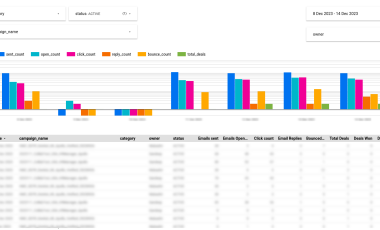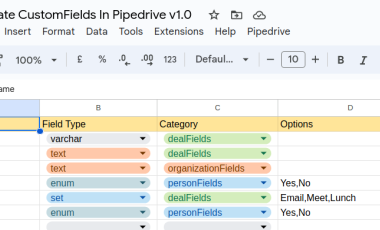Maximizing the Power of Drip Campaigns: Tips and Techniques for Success
Drip campaigns are a powerful tool for marketers looking to nurture leads and drive conversions. By sending a series of automated emails over a period of time, drip campaigns allow you to build a relationship with your audience and gradually guide them towards taking a desired action, such as making a purchase or signing up for a newsletter.
This article will explore the different types of drip campaigns and provide templates to help you get started with your own campaign. From welcome campaigns that introduce new subscribers to your brand to re-engagement campaigns that win back inactive users, we'll cover all the essential drip campaigns and provide examples to help you craft your campaigns. So if you're looking to take your email marketing to the next level, read on to learn more about the different types of drip campaigns and how they can help you achieve your marketing goals.
What Exactly Is a Drip Campaign?
A drip campaign is a type of email marketing strategy that involves sending a series of automated emails to a specific group of recipients over some time. The goal of a drip campaign is to nurture leads and guide them towards taking a desired action, such as making a purchase or signing up for a newsletter.
Drip campaigns can be set up to send emails at predetermined intervals, such as every day or every week. The emails in a drip campaign are typically designed to be highly targeted and personalized, using information about the recipient, such as their location, interests, or past behaviour, to tailor the content of the message to their individual needs or preferences.
Drip campaigns, also called automated marketing or automated email campaigns, are a series of emails sent out at regular intervals or in response to specific actions by users.
The Purpose of the Drip Campaign
Drip campaigns can be used for various purposes, including welcoming new subscribers to a brand, re-engaging inactive users, promoting a new product or service, and more. They can effectively build a relationship with an audience and drive conversions, as the emails in a drip campaign are designed to be highly relevant and valuable to the recipient.
Why Do Drip Campaigns Matter?
Drip campaigns can be an effective way to nurture leads and drive conversions for several reasons:
Personalization
Drip campaigns allow you to send highly targeted and personalized emails to your audience. By using information about the recipient, such as their location, interests, or past behaviour, you can tailor the content of the email to their individual needs or preferences. This can make the email feel more relevant and valuable to the recipient, increasing their engagement with the message.
Timing
Drip campaigns allow you to schedule emails to be sent at specific intervals, such as every day or every week. This can be useful for building a relationship with your audience over time and gradually guiding them towards taking a desired action.
Automation
Drip campaigns are automated, which means you can set them up once, and they will continue to run without requiring additional effort. This can save you time and resources and allow you to focus on other aspects of your marketing efforts.
Measurability
Drip campaigns allow you to track the performance of your emails and see how they impact your audience. You can use this data to optimize your campaigns and improve their effectiveness.
Overall, drip campaigns can be a powerful tool for nurturing leads and driving conversions and can effectively build a relationship with your audience and promote your products or services.
Types of Drip Campaigns
When designing a drip campaign, the following are the most common ones you should keep in mind and consider.
Welcome Emails
Welcome emails introduce your brand and your online or email community to a new subscriber. Welcome emails make your business seem more personal and tell customers what to expect from your emails.
Email 1: Introduction and Welcome
Subject line: Welcome to [Brand]!
Hi [Name],
Thanks for signing up for our emails! We're so glad you're here.
At [Brand], we specialize in [what you do]. We believe that [your brand's mission or values].
In the coming weeks, you can expect to receive [what kind of content you'll be sending them - e.g. newsletters, special offers, tips, etc.].
In the meantime, we'd love for you to connect with us on social media. You can find us on [list your social media channels].
Thanks again for joining us, and we can't wait to share more with you.
Sincerely, [Your name]
In this email, you can introduce yourself and your brand, provide a brief overview of what you do, and give a sneak peek of what the recipient can expect to receive from you in the future. You can also include a call-to-action, asking them to follow you on social media or visit your website.
Email 2:Customer Education
Subject line: [Brand] 101 - A Quick Guide to What We Do
Hi [Name],
We hope you're enjoying your time with [Brand] so far. In case you missed it, we specialize in [what you do] and believe in [your brand's mission or values].
Today, we wanted to take a moment to give you a quick overview of what we do and how we can help you.
[Brand] offers [list your products or services]. Our goal is to [how your products or services benefit your customers].
We understand that choosing the right [product or service] can be overwhelming, which is why we offer [list any resources or support you offer, such as a customer service team or free consultations].
If you have any questions or need any help along the way, please don't hesitate to reach out. We're here to help you every step of the way.
Best regards, [Your name]
In this email, you can share valuable tips, advice, or resource related to your industry or product. You can also include a call-to-action, such as inviting the recipient to learn more about your products or services.
Email 3: Next Steps and Call-to-Action
Subject line: What's Next for [Brand] and You
Hi [Name],
Thanks again for joining the [Brand] community. We hope you've been enjoying the emails and resources we've been sending your way.
As a new member, we wanted to give you a heads up on what's coming up in the next few weeks.
Here's a sneak peek of what you can expect:
- [List any upcoming events, promotions, or new products/services you'll be introducing]
In the meantime, we have a few ways you can get more involved with [Brand]:
- Follow us on social media to stay up-to-date on all things [Brand]: [list your social media channels]
- Visit our website to learn more about what we do: [include a link to your website]
- Share your feedback with us: [include a link to a survey or contact form]
We're always looking for ways to improve and serve our community better, so please don't hesitate to reach out and let us know what you think.
Thanks again for joining us, and we can't wait to see what the future holds for [Brand] and you.
Best regards, [Your name]
In this email, you can offer the recipient a discount or promotion to encourage them to purchase. You can also include a call-to-action, such as inviting them to shop for your products or visit your website.
Onboarding Emails
Onboarding emails help new customers get up to speed with your product or service and provide the information they need to get the most out of it. It talks about specific details like key contacts, links to tutorials etc.
Email 1:
Hi [Name]
Welcome to [Product/Service]!
In this email, you can introduce the recipient to your product or service and provide a brief overview of its features and benefits. You can also include a call-to-action, such as inviting them to start using the product or service.
Email 2:
Hi [Name]
Getting started with [Product/Service].
In this email, you can provide the recipient with step-by-step instructions for using your product or service. You can also include a call-to-action, such as inviting them to contact you if they have any questions or need help getting started.
Email 3:
Hi [Name]
[Product/Service] success stories.
In this email, you can share success stories or testimonials from other customers who have used your product or service. You can also include a call-to-action, such as inviting the recipient to share their success story or learn more about your products or services.
Re-Engagement Emails
These emails are designed to win back inactive users and encourage them to use your product or service again.
Email 1:
Hi [Name]
We miss you!
In this email, you can remind the recipient of the benefits of using your product or service and invite them to come back and start using it again. You can also include a call-to-action, such as offering a special discount or promotion to encourage them to return.
Email 2:
Hi [Name]
[Product/Service] updates.
In this email, you can highlight any new features or improvements to your product or service and invite the recipient to come back and try it out. You can also include a call-to-action, such as inviting them to visit your website or contact you for more information.
Email 3:
Hi [Name]
[Brand] community.
In this email, you can showcase the community of users or customers enjoying your product or service and invite the recipient to join in. You can also include a call-to-action, such as inviting them to follow you on social media or join a discussion group.
Upselling and cross-selling
These emails are designed to promote related products or services to existing customers and encourage them to make additional purchases.
Email 1:
Hi [Name]
[Product/Service] upgrade options.
In this email, you can introduce the recipient to upgraded versions of your product or service and explain the additional features and benefits they can expect. You can also include a call-to-action, such as inviting them to learn more or purchase.
Email 2:
Hi [Name]
[Product/Service] accessory options.
In this email, you can introduce the recipient to accessories or complementary products that can enhance their experience with your main product or service. You can also include a call-to-action, such as inviting them to learn more or purchase.
Lead nurturing
These emails are designed to nurture leads and guide them towards making a purchase or taking the desired action.
Email 1:
Hi [Name]
[Industry] news and updates.
In this email, you can share industry news and updates with the recipient and provide them with valuable information and insights related to your industry or product. You can also include a call-to-action, such as inviting them to learn more about your products or services.
Email 2:
Hi [Name]
[Product/Service] case studies.
In this email, you can share case studies or testimonials from customers who have used your product or service and achieved success. You can also include a call-to-action, such as inviting the recipient to learn more about your products or services or contact you for more information.
Email 3:
Hi [Name]
[Product/Service] demo or trial.
In this email, you can offer the recipient the opportunity to try out your product or service for free or at a discounted rate. You can also include a call-to-action, such as inviting them to sign up for a demo or trial or contact you for more information.
Event promotion
These campaigns promote events, such as webinars or conferences, and encourage people to sign up or attend.
Email 1:
Hi [Name]
[Event] overview.
In this email, you can provide the recipient with an overview of the event, including the date, location, and main speakers or presenters. You can also include a call-to-action, such as inviting them to learn more or sign up to attend.
Email 2:
Hi [Name]
[Event] speaker profiles.
In this email, you can introduce the recipient to the main speakers or presenters at the event and provide a brief overview of their expertise and background. You can also include a call-to-action, such as inviting them to learn more about the speakers or signing up to attend.
Email 3:
Hi [Name]
[Event] early bird special.
In this email, you can offer the recipient a special discount or promotion to encourage them to sign up to attend the event. You can also include a call-to-action, such as inviting them to register or contact you for more information.
Product promotion
These emails promote specific products or services and encourage people to purchase.
Email 1:
Hi [Name]
[Product/Service] introduction.
In this email, you can introduce the recipient to your product or service and provide a brief overview of its features and benefits. You can also include a call-to-action, such as inviting them to learn more or make a purchase.
Email 2:
Hi [Name]
[Product/Service] customer testimonials.
In this email, you can share customer testimonials or success stories that showcase your product's or service's benefits. You can also include a call-to-action, such as inviting the recipient to learn more about your products or services or contact you for more information.
Email 3:
Hi [Name]
[Product/Service] special offer.
In this email, you can offer the recipient a discount or promotion to encourage them to purchase. You can also include a call-to-action, such as inviting them to shop for your products or visit your website.
The Steps Involved in Designing a Drip Campaign
Define your goals
Before you start designing your drip campaign, it's important to define your goals. What do you want to achieve with your campaign? Are you looking to nurture leads, promote a new product, or re-engage inactive users? Clearly defining your goals will help you determine the type of drip campaign that will be most effective for you.
Identify your target audience.
Next, you'll need to identify the specific group of people you want to reach with your campaign. Who are your ideal customers or clients? What are their needs, interests, and preferences? Knowing your target audience will help you tailor your message and choose the right type of drip campaign.
Create a campaign schedule
Decide how often you want to send emails as part of your drip campaign and the intervals between emails. For example, you might send an email every day for the first week, followed by a weekly email for the next month.
Develop your content
Next, you'll need to develop the content for your emails. This will involve deciding on the specific message you want to convey and the type of information you want to include in each email. You'll also need to create graphics or images to support your message.
Set up your automation
Once you have your content and schedule, you'll need to set up your automation. This will involve choosing an email marketing platform or tool that allows you to create and schedule your drip campaign. Many options are available, so be sure to research your options and choose the one that best meets your needs.
Test and optimize
Before launching your drip campaign, test your emails to ensure they are functioning correctly and visually appealing. You should also pay attention to the results of your campaign and use data to optimize and improve your emails over time. This can involve testing different subject lines, messaging, or calls to action to see what works best.
Final Word
Drip campaigns are a powerful tool for marketers looking to nurture leads and drive conversions. By sending a series of targeted, personalized emails over some time, drip campaigns allow you to build a relationship with your audience and guide them toward taking a desired action.
Many drip campaigns can be used for various purposes, including welcoming new subscribers, re-engaging inactive users, promoting events, and more. By carefully considering your target audience and the type of message you want to convey, you can choose the right drip campaign to help you achieve your marketing objectives. Designing a drip campaign involves a combination of strategy and execution.
By continually testing and optimizing your emails, you can create a powerful and effective campaign that helps you achieve your marketing goals.
We have reviewed and tested multiple tools to help you automate your drip campaigns. Contact us if you need support selecting, configuring and integrating the tools in your marketing workflow.



